#1930's film stars
Text

Barbara Kent was a Canadian film actress, prominent from the silent film era to the early talkies of the 1920s and 1930s. In 1925, Barbara Kent won the Miss Hollywood Beauty Pageant.
#vintage#beauty#actress#girl smoking#barbara kent#canadian actress#silent film stars#silent era#1920's#1930's#miss hollywood
11 notes
·
View notes
Text

Director/Producer William Asher and Elizabeth Montgomery (his wife at the time), most likely on the set of Bewitched.
#bewitched#classic tv#classic film#1930s#1940s#film noir#black and white film#i love lucy#lucille ball#1960s tv#golden hollywood#elizabeth montgomery#60s pop stars#60s blondes#60s#60's tv#60s icons#60s fashion#witches#witchblr#witchcore#witch#witchcraft#polka dots#dolly shots#dollycore#on set#on set photos#on set pictures#on location
7 notes
·
View notes
Photo
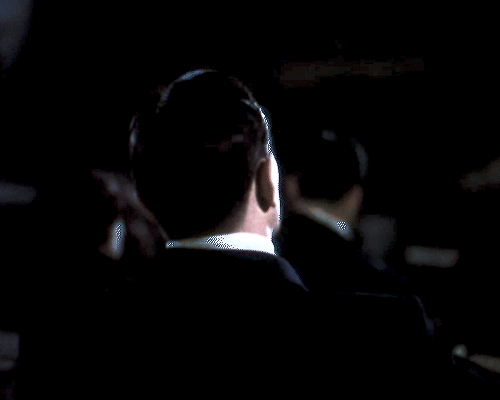


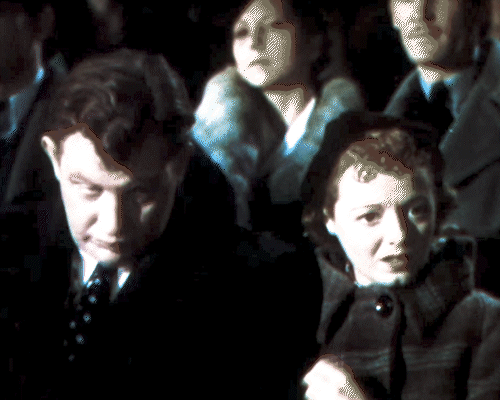

A Star is Born (1937) dir. William A. Wellman
#classic film#classicfilmgifs#a star is born#1930's#1930's cinema#classicfilmsource#oldhollywood#oldhollywoodedit#dramaedit#romanceedit#mygifs#filmgifs#fredric march#janet gaynor#andy devine
31 notes
·
View notes
Text

Today In History
Billie Holiday, influential blues legend, was born in Philadelphia, PA, on this date April 7, 1915.
Holiday first rose to prominence in the 1930’s with a unique style that reinvented the conventions of modern singing and performance. More than 80 years after making her first recording Billie’s legacy continues to embody what is elegant and cool in contemporary music.
Also known as Lady Day, Billie Holliday autobiography was made into the 1972 film Lady Sings the Blues starring Diana Ross as Billy Holiday.
The evocative, soulful voice which she boldly put forth as a force for good, turned any song she sang into her own.
Today, Billie Holiday is remembered for her musical masterpieces, her songwriting skills, creativity and courageous views on inequality and justice. In 2000, Holiday was inducted into the Rock and Roll Hall of Fame.
In 2021 the film The United States vs. Billie Holilday Directed by Lee Daniels @leedaniels and stars Andra Day @andradaymusic in the lead role playing Billie Holliday won the Golden Globe Award for Best Actress in a Motion Picture – Drama, and was nominated for an Academy Award for Best Actress.
CARTER™️ Magazine
#billie holiday#carter magazine#historyandhiphop365#wherehistoryandhiphopmeet#history#carter#cartermagazine#today in history#staywoke#blackhistory#blackhistorymonth
60 notes
·
View notes
Text
Which decade had the better movies?


The 1970's was the beginning of Hollywood's silver age. Films were becoming more gritty and realistic. This was the birth of the Hollywood blockbuster, and there was also a big market for independent films. Exploitation, grindhouse, Blacksploitation, independent horror and more.
Popular movies of the 70's include: Star Wars. Enter the Dragon, Alien, Jesus Christ Superstar, Up in Smoke, Fantastic Planet, Saturday Night Fever, The Godfather, The Exorcist, Dolemite and Grease.
The 1930's was the beginning of Hollywood's golden age. Silent films were on their way out in the beginning of the decade and talkies soon took over. This was the decade of the studios and big Hollywood stars. When people think of Hollywood, they're often thinking of the 1930's aesthetic.
Popular movies of the 1930's include: The Wizard of Oz, Frankenstein, Dracula, Gone With the Wind, Snow White and the Seven Dwarfs, Modern Times, King Kong, Freaks, The Public Enemy and Bringing Up Baby.
49 notes
·
View notes
Text
Brazil and The Dream of Escape

I was delighted to find in the Xtras that the machine created to be used by Furfur to use to find out how many demons Shax could requisition for storming the bookshop was inspired by the movie Brazil. This is another nod to Monty Python member Terry Gilliam, who directed this film, and who almost directed the failed GO film in the 1990's.
I love this film. Always have. Yes, I was around when it came out in 1985. I'm that old. It's always been in my top 5 favourite films. And its totally relevant to Good Omens.
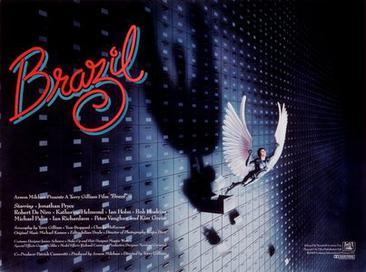
Brazil can be described as a dark dystopian story based on the novel 1984. It doesn't have a happy ending, but its funny, horrific, ludicrous, romantic and timelessly beautiful all at the same time. Its so iconic that when ever I see its influence in other productions its been unmistakable.
It stars Jonathan Pryce long before he was a James Bond villain or the head Sparrow in Game of Thrones, a comedic turn from Robert de Niro and a handful of other famous faces that you are bound to recognise, such Bob Hoskins, Ian Holm and Jim Broadbent.
Pryce, as Sam Lowry, lives in a world that is strictly controlled with paperwork that comes in multiple copies, where people are routinely arrested and tortured and a long running unexplained terrorist campaign sees bombs explode in the most random of places. Sam has dreams of a beautiful woman floating in the sky, and he is a sliver-armoured winged hero trying to rescue her. He eventually finds that she is real, and finds out her name through various means via his work and contacts. He tracks her down, but that is where it all starts to unravel as she is mixed up with an unfortunate case of mistaken identity.


Its easy to see the common themes and elements that run through the film with GO: the desire to run away and escape (that doesn't work,) a totalitarian authority controlling the masses, propaganda, piles of paperwork, an undercurrent of rebellion, torture and abuse, forbidden love between classes, a villain hidden in plain sight.
There is an art deco aesthetic to the film that also carries over to other films and shows it has influenced, and the busy work floor scene that stops on a dime to watch the tv show de jour while the boss isn't looking is one of the highlights of the film.
It was a reference of this that caught my eye in the Cohen Brothers modern fairy tale The Hudsucker Proxy, where they copied the busyness of the work floor for their mail room scenes, but also the art deco aesthetic. That's another film that is always in my top five films, and could go a round of comparisons with GO - its got time stoppage, an angel appearance and a near-godlike manipulator.

It also appears, surprisingly, in Star Wars: The Last Jedi. The casino at Canto Bight is Brazil inspired, in the way its introduced to us, its decor and the music. I know some people hate this film because of what they did to Luke, but I love it, the whole thing is just utterly gorgeous to look at.
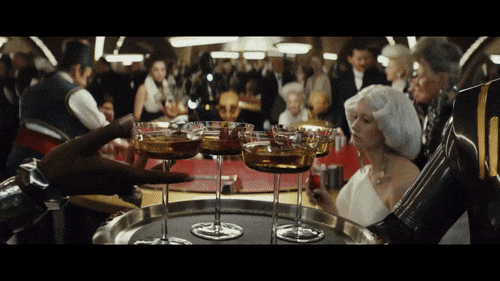
And if you've watched any of Loki recently, since S2 of that show finished not long ago, you would also seen some influence from Brazil in the retro look.
I love the classic art deco style. my grandparents had an art deco house that I spent many of my childhood hours in. The style itself is a clean, unadorned look, and often is meant to give a look of movement, speed or strength. A classic example of this is the Bentley, of course, which comes from the height of the art deco era in the 1930's.

Hell is the other place we see the Brazil influence in GO, where is looks like it's constantly several decades behind the times, with overhead projectors and manual typewriters and odd looking not-quite steampunk contraptions.
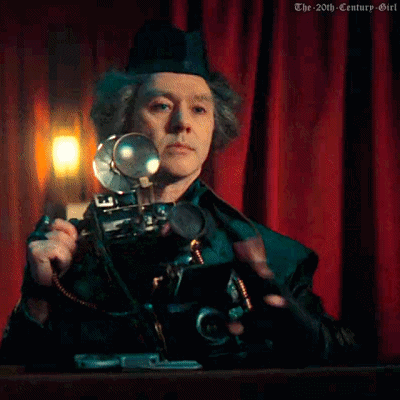
Brazil is available to stream on Disney at the moment, if you'd like to take a look. I highly recommend it, its one of those influential films that once you know it, you see its long reach in the most unexpected places.
#good omens 2#good omens meta#good omens analysis#shax#furfur#terry gilliam brazil#monty python#the bentley#art deco
62 notes
·
View notes
Text

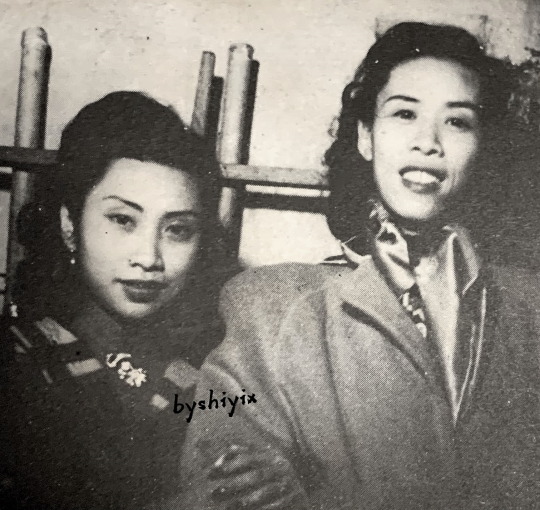
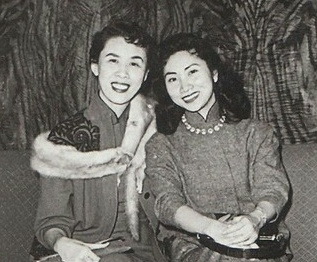
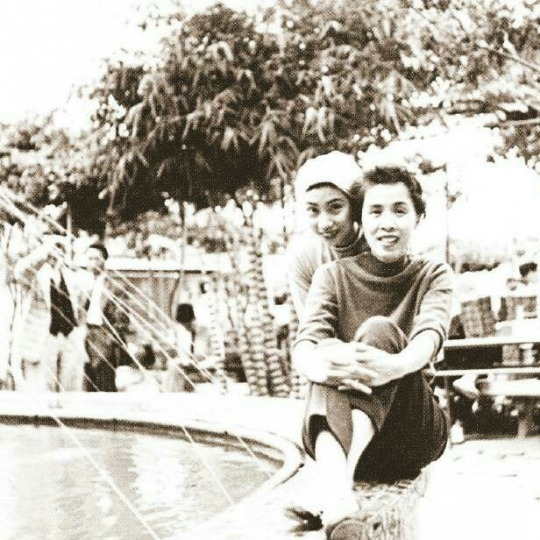

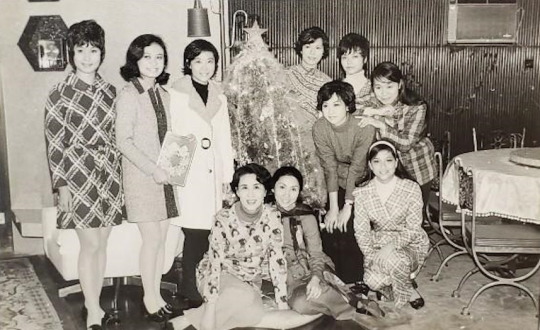
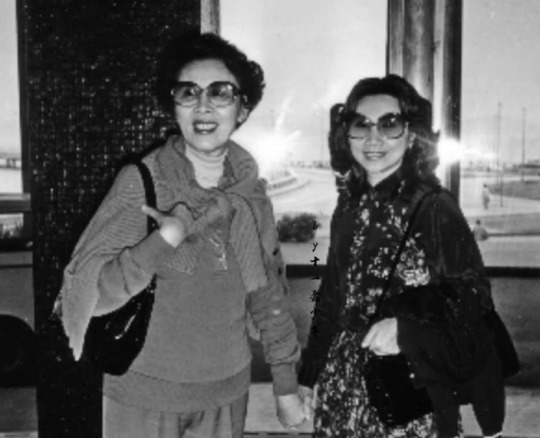

Female Queer Icons of Hong Kong // Yam Kim Fai (任劍輝) and Pak Suet Sin (白雪仙)
Photo 1: Promotional photo for 1955 contemporary movie The Model and the Car (玉女香車) (no video available) (Source: LCSD Museum Collection Search Portal)
Photo 4: Photo from Sin Fung Ming Opera Troupe's 1958 trip
Photo 5: Photo from a 1962 newspaper feature on Yam, Pak, and others at their (?) summer villa in Central, Hong Kong
Photo 6: Christmas celebrations with Yam, Pak, and their protégés of the Chor Fung Ming Troupe
Far and away the most iconic duo in Cantonese opera, Yam Kim Fai (任劍輝) and Pak Suet Sin (白雪仙) – commonly referred to simply as Yam-Pak (任白) – were famed for their partnership both on and off the stage… Click below to learn more!
Edit on 28/07/2023: Updated to link to a photo of the entrance to the Hong Kong Heritage Museum’s Pop Culture 60+ exhibit, and to add information regarding Yam and Pak's marriage status.
Iconic? How?
Yam-Pak are the face of Cantonese opera; you can't talk about the latter without mentioning the former. It's to the point where a gigantic picture of them graces the entrance to the Hong Kong Heritage Museum’s permanent exhibition on Hong Kong pop culture’s evolution across the past 60 years (“Hong Kong Pop 60+”) - they are the first thing you see upon entering!
Best known as the originators - with Yam playing the male leads and Pak the female leads - of five masterpieces of Cantonese opera, namely:
1. Princess Cheung Ping (帝女花)
2. The Legend of the Purple Hairpin (紫釵記)
3. The Dream Tryst in the Peony Pavilion (牡丹亭驚夢)
4. The Reincarnation of Lady Plum Blossom (再世紅梅記)
5. Butterfly and Red Pear Blossom (蝶影紅梨記)
(Note: Princess Cheung Ping, Purple Hairpin, and Butterfly and Red Pear Blossom were made into abridged movie versions, with the Sin Fung Ming troupe members reprising their roles from the theatre productions. Also, the "Fragrant Sacrifice" (香夭) duet from Princess Cheung Ping (movie clip) is one of - if not the most - famous songs in Cantonese opera.)
Yam and Pak were the leading pair and co-founders of the legendary Sin Fung Ming Opera Troupe (仙鳳鳴劇團; 1956-1961), which is widely held to have pushed Cantonese opera forward as an artform due to Pak and scriptwriter Tong Tik Sang’s (唐滌生) emphasis on poetic libretti and adapting source material from Chinese literature and history. (Note: it has been common practice since the 1930's for Cantonese opera troupes to be founded by key actor(s).)
They were also very active in the Hong Kong film industry in the 1950's, being paired in over 40 movies together across roughly 8 years. One of those – the aforementioned Butterfly and Red Pear Blossom (蝶影紅梨記) – is the sole Cantonese opera movie on the Hong Kong Film Archive’s 100-Must See Hong Kong Movies list (IMDB list / archived version of the official PDF). It's a well-deserved inclusion - check out this beautifully-shot dance scene.
Even their post-retirement activities had a significant effect on the industry! In the early 1960’s, they held auditions for prospective students and provided - for free - systematic, hands-on training to those who passed; Yam and Pak even hired other veterans to teach skills they personally were not as familiar with. Prior to this, apprentices were expected to learn primarily from observing their masters, and to pay handsomely for the privilege. Yam-Pak’s methods proved exceedingly effective: the Chor Fung Ming Opera Troupe (雛鳳鳴劇團; 1963-1992) starring their apprentices reigned supreme in the 1970’s-1980’s. Following this success, Cantonese opera institutes - most notably the major 1900s-era guild, the Chinese Artists Association of Hong Kong (八和會館) - started to offer systematic coaching to young hopefuls in the 1980's.
Okay, so why are they queer icons specifically?
The lazy answer is that they're queer icons because nearly all of Yam's roles were male, so Gender is involved by default, and since most hit Cantonese operas of the time were romances, that means you get to see two female actors performing being in love onscreen (and also on stage, but there aren't any video recordings from back then). So far, so Takarazuka Revue.
Female actors playing male roles in Cantonese opera
To give some context, each Cantonese opera performer specialises in one of four major role-types, and Yam was a sung (生) - i.e. an actor specialised in playing standard male roles. Female sung were fairly common in the 1910's-1930's due to women being banned from performing with men during that period, but when the ban lifted in the mid-1930's, many troupes shifted towards cis-casting. Yam was pretty much the only one whose popularity survived the transition. Just take a look at the huge number of Cantonese opera movies produced during the 1950’s-1960’s – you’ll be hard-pressed to find a female sung other than Yam, let alone one with top billing.
Happily, thanks to Yam's immense popularity, her profilic film career (over 300 movies!), and the prominence of Sin Fung Ming works in the Cantonese opera canon, there has been a resurgence in female sung which endures to this day. Two noteworthy examples are Yam's protégé Sabrina Lee/ Loong Kim Sang (龍劍笙) - a star in her own right - and Joyce Koi/ Koi Ming Fai (蓋鳴暉), one of the biggest names still active in the industry.
(Note: perhaps due to cinema being more "realistic" in nature, Yam's early movies often involved her playing female characters cross-dressing as men, including in some Cantonese opera movies. However, she received increasingly more male roles as her fame grew, and from the mid-1950's onwards she was playing male characters onscreen nearly exclusively-- even in non-Cantonese opera movies! See Photo 1 above.)
What sets Yam and Pak apart is that they were particularly known for their chemistry. Long before Sin Fung Ming's formation in 1956, the advertising copy for their first Cantonese opera movie together - Frolicking with a Pretty Maid in the Wineshop (酒樓戲鳳, 1952) - declared "Only this movie has Yam-Pak flirting on the silver screen" (source - 華僑日報 1952/05/23-26). And indeed, they were popular for their flirtatious duets: their Cantonese opera works invariably contained at least one, and such scenes made it into some of non-Cantonese opera (i.e. "contemporary") movies too. In fact, there are not one but two contemporary movies where Yam and Pak's characters are not paired up and yet still sing a duet together in such a way that their significant other(s) become convinced that the two are in romantically interested in each other - see 1952's Lovesick (為情顛倒) and 1956's The Happy Hall (滿堂吉慶) - a weirdly specific situation which doesn't crop up in the other, non-Yam-Pak movies I have seen.
Speaking of contemporary movies, let's talk about a certain plotline that keeps cropping up in works featuring the both of them and where Yam plays a woman! Six of the eleven movies which fit that criteria involve Yam's character cross-dressing as a man (a common characteristic across Yam's handful of female roles), and Pak's character falling for her. Nothing ever comes of it, of course, but, um. It was certainly a trend. Actually, even their very first movie together - 1951's Lucky Strike (福至心靈) - falls into this category.
Such storylines, and the emphasis on their chemistry, are particularly interesting given that both Yam and Pak remained ostensibly unmarried throughout. This was unusual for female performers of their stature, who tended to wed in their twenties, often to fellow-actors or wealthy men (e.g. Hung Sin Nui/紅線女, Fong Yim Fun/芳艷芬, and Tang Pik Wan/鄧碧雲)... In contrast, by the time Yam-Pak retired from the stage in 1961, they were both over 30 years old and without husbands.
Also, did I mention they were popularly believed to be living together? There doesn't seem to be any conclusive evidence either way... although it's a little strange that separate newspaper pictorials depicting "Yam at home" and "Pak at home" seem to be of the same location... however what is conclusive is that they did spent a lot of time together offstage. Pak has talked about how when they had no guests over, Yam would watch TV by herself while Pak was in the living room (source - p93), and protégé Mandy Fung/ Mui Suet Sze (梅雪詩) has said that Pak would sometimes cook for Yam at home (source - 03:53~). They would also celebrate birthdays, New Year's, and Christmas together (see Photo 6 for an example of the latter).
Shortly after Yam's passing in 1989, Pak set up the Yam Kim Fai and Pak Suet Sin Charitable Foundation (任白慈善基金) to support the arts and provide welfare for the elderly. In 1996, Pak made a large donation to Hong Kong University, resulting in one of the buildings being renamed Yam Pak Building (任白樓) in thanks (source).
Thanks for reading! Please feel free to DM me or send an ask if you have any questions, or are just interested in learning more.
If you made it here, have this bonus piece of trivia - Yam and Pak were also well-acquainted with Hong Kong's preeminent queer icon, Leslie Cheung (張國榮), who was a massive fan of theirs. Sadly there don't seem to be any pictures of them before Yam's passing, but here's one of Pak (centre) having afternoon tea with Cheung (left) and his long-term romantic partner Daffy Tong (唐鶴德) (right) at the Cova cafe in the Pacific Place shopping mall.
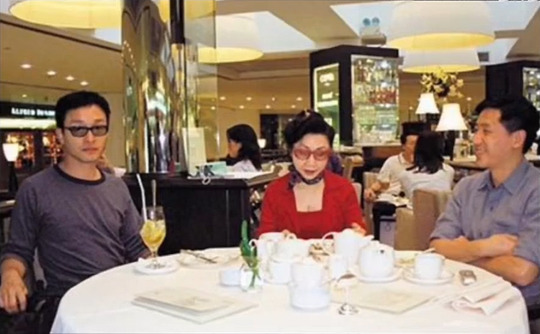
#wlw recommendations#sapphic#lgbtq#asian lgbtq#hong kong#theatre#cantonese opera#chinese opera#yam kim fai#leslie cheung#pak suet sin#yampak#yambak#pak sheut sin#bak sheut sin#hong kong queer icons#not me hastily adding tags because i keep forgetting certain ones
146 notes
·
View notes
Text
Hey lovely Lugosi freaks, I uncovered something cool on our guy.

He wore this smoking jacket with a moon and star motif in The Raven (1935). I thought it was quite pretty, so I remembered it.
Lugosi must have thought it looked good too, because this jacket appears his films all the way back to Hungary. It’s no movie prop; it must’ve his own piece that he kept almost 20 years and brought across the ocean.
It’s a little surprising, as he is said to have owned almost nothing else other than his WW1 Hungarian lieutenant’s uniform when he emigrated to America in 1922.
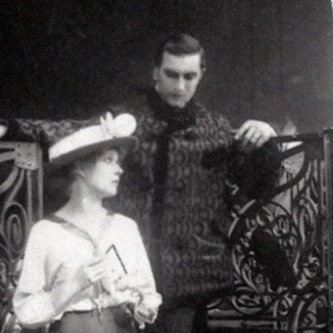
Lugosi in Küzdelem a Létért (The Leopard), a 1918 Hungarian silent film.

In Daughter of the Night, or Der Tanz auf dem Vulkan ‘The Dance on the Volcano’ (1920), a German silent film.
Finally, The Raven (1935), an American film:

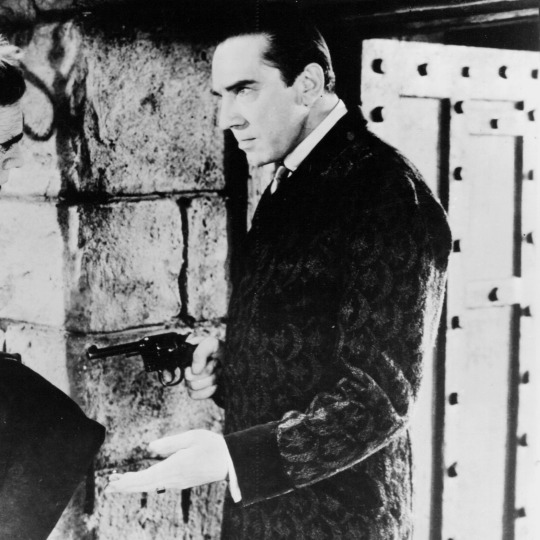
Aside from me wanting to do the girl-steals-a-guy’s-hoodie-thing to a man in the 1930’s, I thought it was a neat little fact about Béla.
#bela lugosi#bela dracula lugosi#béla lugosi#dracula#hungarian actor#old hollywood#vintage#actor#vintage horror#the raven 1935
47 notes
·
View notes
Text
The Great Greta Garbo

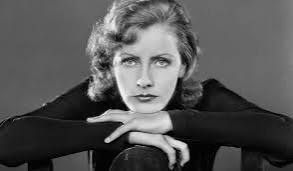
Glamorous, compelling, and ever so famous was the iconic movie star, Greta Garbo. She graced Hollywood in the 1920s and 1930s with films like “Wild Orchids” and “The Kiss.” Altogether, she starred in thirty-three films and captivated men and women alike.
Greta was born Greta Lovisa Gustafsson on September 18, 1905 in Stockholm, Sweden and died April 15, 1990 in New York City at the age of 84 to pneumonia. Her childhood was that of poverty where her family lived in the slums. Her father was an itinerant laborer and didn’t earn much money to give his family the life he wanted for them to have. When Greta was old enough to work, she took various positions to help ease the strain of supporting the family.
One fateful day, film director Erik Petschler saw Greta and was mesmerized with her beauty after seeing her in a commercial advertising women’s clothing and he offered her a small role in his 1922 film “Peter the Tramp.” She was bitten by the acting bug and she started school at the Royal Dramatic Theater in Stockholm. She landed a major role in a 1925 Swedish movie “Gösta Berlings Saga” (The Saga of Gösta Berling). The director, Mauritz Stiller changed her birth name to Garbo as he felt it was fitting and becoming for her unique beauty. Seeing her potential, he negotiated with MGM (Metro-Goldwyn-Mayer) Studios in Hollywood and secured her a contract. Louis B. Mayer had doubts about Greta’s screen performance until the release of her first American 1926 film “The Torrent.” Her lustrous glow and the fluidity of how she moved impressed Mayer so much so that he gave her an exclusive contract.
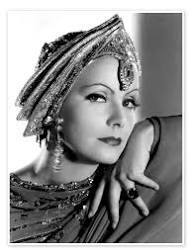
1930’s “Anna Christie” was Greta’s first sound film. The movie was marketed with “Garbo talks!” She would earn three Oscar nominations for best actress for her performances in “Anna Christie,” “Camille,” and for “Ninotchka.” She never did win, but she did receive an Honorary Academy Award in 1955. She won the New York Film Critics Circle Award for best actress for her performance in 1935’s Anna Karenina. Her last film was “Two-Faced Woman” in 1941 and it received bad reviews that greatly humiliated her. Her acting life halted despite offers for other films after the movie flop.
Greta never married nor did she have children. Her first romance was with her often co-Star John Gilbert. In her latter years, she had a relationship with Leopold Stokowski, conductor of the Philadelphia Orchestra. It’s rumored that she had an affair with Russian-born millionaire George Schlee, stealing him from his wife. It’s specualted that Greta was bisexual, some would claim she was predominantly lesbian, but no one could confirm that. Though she appeared in events, she disliked the feeling uncomfortable acting like a socialite because it wasn’t who she was.
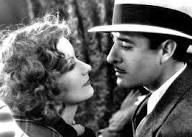
Greta would live the remainder of her life in a New York City apartment. She was an honored guest in the White House and She received treatment for breast cancer and would have dialysis treatment at a local hospital where she would later die from pneumonia. She will always be regarded as one of the most beautiful and graceful women that gifted us with her talent.
Until next time, Aloha oe.
Photos: *Getty Images, Posterlounge
#greta garbo#golden age#movie talk#movie time#movie theater#historical#actress#old hollywood#black and white movies#silent movies#silent film#movie star#hollywood history#hollywood#hollywood legend#actor#silent film actresses#hollywood actress#famous#movies#movie theme#league of legends#legendary actress
15 notes
·
View notes
Text
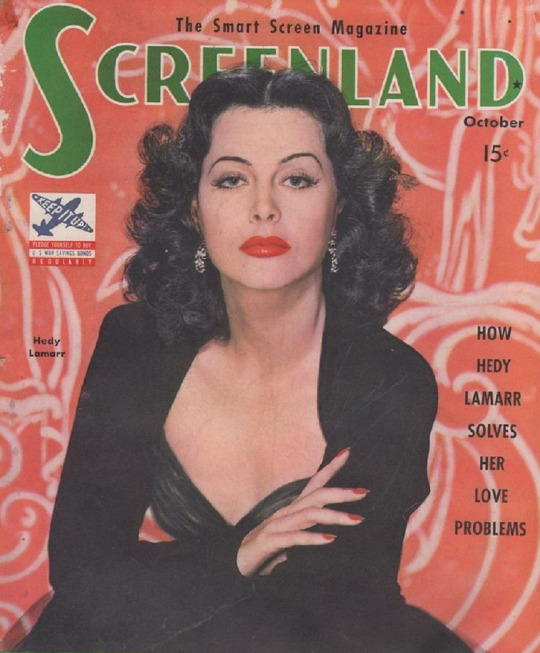
Hedy Lamarr on the cover of Screenland magazine (October 1942).
Happy heavenly birthday to Hedy Lamarr.
Born to Jewish parents in 1914, Lamarr became one of the defining actresses of Hollywood’s Golden Age, and the inventor of a frequency hopping technology used by Allied Forces in World War II to avoid threats of jamming by the Axis Powers. She is considered an essential pioneer in wireless technology, as her invention later formed the basis of WiFi, Bluetooth, and GPS.
One of the biggest film stars of the 1930’s and 1940’s, Lamarr was also an inspiration behind the design of the Catwoman character.
She passed away on January 19, 2000.
She was posthumously inducted into the National Inventors Hall of Fame in 2014.
May her memory be a blessing.
#hedy lamarr#jewish#pop culture#history#old hollywood#golden age of hollywood#golden age#vintage#classic hollywood#jewish culture#jewish pop culture#jewish artists#jewish community#jewish beauty#jewish women#women inventors#women’s history#throwback#nostolgia#1930s#1940s#catwoman
28 notes
·
View notes
Text
(A timeline of events from an outsider’s perspective, based on @bendyredrawn ‘s very own timeline! In this world, JDS’s growth is much like Fleischer Studios, with some things from Disney.)
1919 - Joey Drew Studios is created by Joey Drew and Henry Stein. They also release their first short, “Little Devil Darlin'“. It stars a misunderstood little imp that tries to keep a job in turning people to sin. It becomes a hit with minority groups, such as immigrants, as escapism from the riots of the time, and conservative whites of New York find it blasphemous.
1920 - “Imp from the Inkwell“ Is released. In this story, the imp, now named Bendy, gets into antics with a live action Henry Stein. The production of short comics also start, introducing an unnamed hellhound into the picture.
1922 - More cartoons and comics are made. Notably, Boris makes his entrance in “Boorish Beasts”. He is Bendy’s acquaintance and foil, being quiet and calculative, but warm-hearted.
1925 - The Bendy film “Tombstone Picnic” makes a breakthrough by becoming the first ever animated “talkie” through vitaphone. The titular character is voiced by none other than Joey himself. Joey Drew Studios hits the top of the charts for animation in America.
1926 - Another series, Telltale Trio, is introduced into the catalogue. It is not focused on the well-known imp from hell, but instead a trio of ghastly animals haunting a small town.
1927-1930 - Countless other comics and talkies are released. The idea of angels are also introduced to the Bendy series. JDS grows exponentially in young employees during the start of the Great Depression.
1932-1933 - One year of mostly comics. Rumors go around that JDS is buying out a new studio in the Brooklyn area to house all its new departments. Joey Drew mentions big things are coming, but keeps it a surprise.
1933 - Construction finishes on the new studio and production moves in. Several female singers, musicians, and foley artists are also hired around this time. Alice Angel is introduced: a trigger-happy messenger that’s ended up in Hell. This also marks the year of JDS’s first color film.
1934 - With the addition of the Hays code, JDS holds back on all the violence, and produces less Bendy cartoons. Strangely enough, its reputation and income is barely effected. Alice Angel becomes the darling of the show around this time.
1936 - JDS releases a feature-length on the return of Bendy. It becomes extremely popular. But at the same time an endemic of sickness spreads throughout New York for a few days. There are also reports of some theatres receiving completely corrupted canisters that have whole minutes blacked out, melting, or incomprehensible.
1937- Henry Stein leaves the company because of “creative differences”. The studio’s growth comes to a halt.
1937-1940 - Production slows on more Bendy cartoons, instead focusing on other series again. Employees start protesting for better treatment outside the studio.
1940-1943 - Employees of the studio start to go missing, along with other employees leaving in droves. All report sickness.
1944-1945 - The studio, again, advertises a new breakthrough. A few more cartoons come out, all focusing on Bendy. People near the studio report cold chills and auditory hallucinations for months upon end.
1946 - After a mass plunge into hysteria from people in the near vicinity of JDS for 3 hours, The studio goes completely silent. All people employed go missing. Many investigations are taken out under these disappearances, but all become cold cases. People that go in don’t come out. Eventually, the studio is demolished.
1963 - New animation released. Henry is told by Joey to record the old studio. Game events.
#bendy and the ink machine#bendy au#ootim#out of the ink machine#what I’ve got right now!#this might change in the future#but I think this is good for now!#text#I’ve been saving this but thought I’d just post it
12 notes
·
View notes
Text
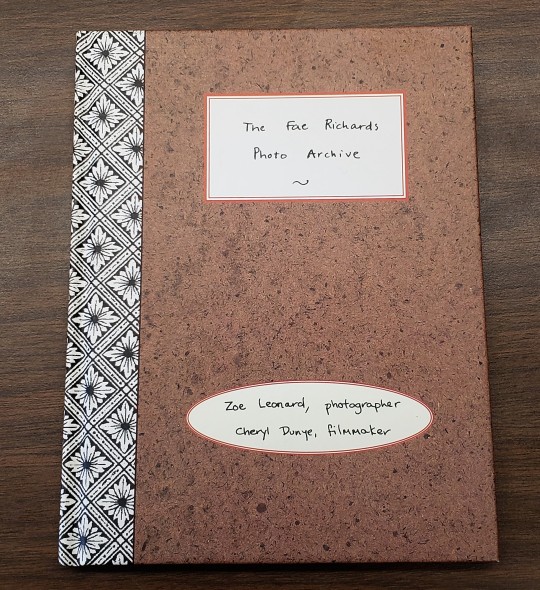



Past and Present: Cheryl Dunye’s The Watermelon Woman
Last year, Special Collections and Archives at the University of Iowa Libraries acquired items to form a new collection: the Black Film and Television Collection. In honor of Black History Month, we’re shining a spotlight on a different item from this collection each week.
In yesterday’s post, we discussed the original script for 1971’s Shaft, a defining entry in the Blaxploitation genre. Our final spotlight shines on a unique photo book from 1996, when Cheryl Dunye’s The Watermelon Woman attempted to excavate the history of queer Black women on screen.
Cheryl Dunye and New Queer Cinema
With The Watermelon Woman, Dunye became the first Black lesbian to direct a feature film. This movie belongs to a genre that came to be called New Queer Cinema, a movement in independent film during the 1990s that placed queer characters at the center.
The film was critically acclaimed and regarded as one of the foundational films of the genre, and it was added to the Library of Congress’ National Film Registry in 2021.
It also gave new momentum to Dunye’s career in film and television, which continues to this day. Her recent directing credits include The Umbrella Academy, Bridgerton, and Queen Sugar.
Unnamed & Uncredited
The Watermelon Woman stars writer and director Cheryl Dunye as an aspiring documentarian who works at a video rental store. Dunye’s fictional proxy, also named Cheryl, is fascinated by the history of Black women in film, particularly those who went unnamed and uncredited for roles portraying the racist archetypes that were common in the cinema of the 1930s and 40s.
In the movie, Cheryl embarks on a journey to discover the name of Black actress only identified as “The Watermelon Woman.” She eventually uncovers the woman’s real name, Fae Richards, and discovers that she, too, was a queer woman.
A Supplementary Archive
Fae Richards may be a fictional character, but she stands for countless queer Black people whose stories have been omitted from the record. Artist Zoe Leonard, in collaboration with Cheryl Dunye, created The Fae Richards Photo Archive, a series of 82 images that document the life of this fictional character. From candid shots, family photos, and publicity pictures, every image matches a time and place of this character. As the Whitney Museum of American Art explains, “Leonard acknowledges the project’s artifice, encouraging the viewer to recognize that she had to create a story that is fictional, but rings true, because the real life counterparts of such stories went undocumented.”
This statement demonstrates exactly why many archives are, or need to, work to fix the mistakes of the past. As a school with a rich screenwriting history, it is why the University of Iowa Libraries is actively working to collect more stories from Black cinema.
A Century of Black Film
During this series, we’ve looked at four iconic examples of Black filmmaking. But that’s not to say that the work of Black filmmakers can be reduced to four eras, or that the films we discussed are more important than those that didn’t make this list. There’s so much more to discover in the Black Film and Television Collection, and if you’ve enjoyed this blog series, we encourage you to check out what’s available online. As The Watermelon Woman attests, the preservation of these stories, and the names and lives behind them, is vital and rewarding work.
--Natalee Dawson, Communication Coordinator at UIowa Libraries, with assistance from Liz Riordan, Anne Bassett, and Jerome Kirby
#watermelon woman#libraries#blackhistorymonth#black film#uiowaspecialcollections#film#uiowa#black history matters#Cheryl Dunye#Zoe Leonard#Fae Richards
94 notes
·
View notes
Text
Propaganda Poster @ shooting location.
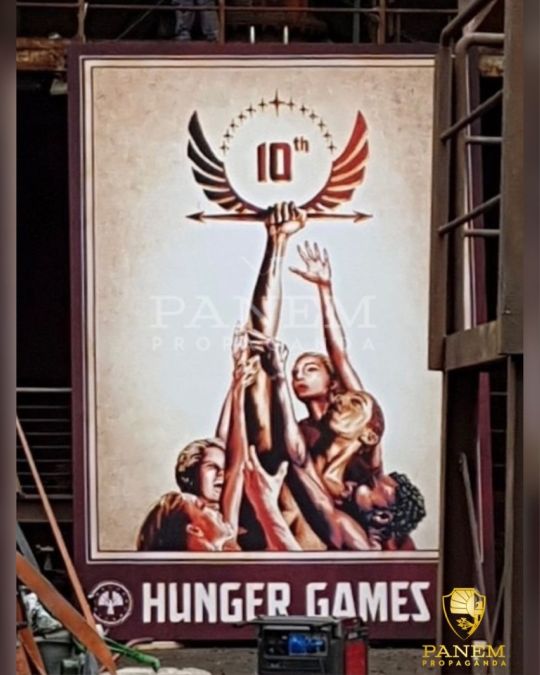
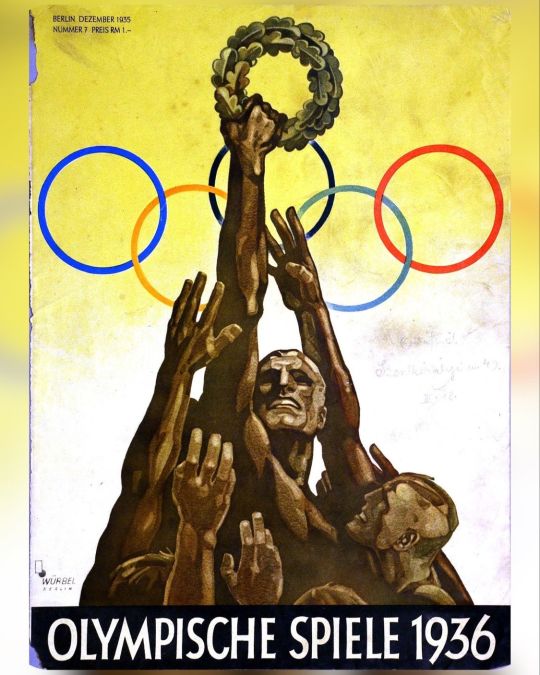
#Repost from IG
@ panem_propaganda: Exclusive From The Ballad of Songbirds and Snakes set! This 10th Hunger Games poster was photographed when they were filming at Landschaftspark-Nord, Duisburg, Germany back in August and sent to us by someone who wishes to remain anonymous. Some details: You can see 13 stars on the poster - possibly representing the 12 districts and the larger star perhaps for the winner, or for the Capitol? There are also 12 wings on the ring.
The style is directly inspired by German propaganda of the 1930’s. For example, the 2nd picture is an actual cover of the program for the 1936 Berlin Olympics, an extremely controversial Olympics.
#the ballad of songbirds and snakes#tbosas#the hunger games#thg#coriolanus snow#lucy gray baird#tbosas movie#suzanne collins#ballad of songbirds and snakes#tom blyth#rachel zegler#tbosas misc#propaganda#tbosas bts#bts#poster
318 notes
·
View notes
Photo


set location: vasquez rocks (North of L.A.)
The opening scene in "Tibet" was filmed at Vasquez Rocks, well known to Star Trek: The Original Series (1966) fans as the rock outcropping from where Captain Kirk rolled a boulder down trying to kill the Gorn in Star Trek: The Original Series: Arena (1967).
#werewolf of london#1935#star trek the original series#arena#captain kirk#gorn#old hollywood#horror film#filmedit#horroredit#1930's#1930's films#william shatner#1967#mygifs#vasquez rocks#vasquez rocks natural area park#set location
6 notes
·
View notes
Text

Today In History
Cabell “Cab” Calloway, accomplished bandleader, singer, dancer, songwriter, and author, was born in Rochester, NY, on this date December 25, 1907.
He learned the art of scat singing before landing a regular gig at Harlem’s famous Cotton Club. Following the enormous success of his song “Minnie the Moocher” (1931), Calloway became one of the most popular entertainers of the 1930s and ‘40s.
With other hits that included “Moon Glow” (1934), “The Jumpin’ Jive” (1939) and “Blues in the Night” (1941), as well as appearances on radio, Calloway was one of the most successful performers of the era.
He appeared in such films as The Big Broadcast (1932), The Singing Kid (1936) and Stormy Weather (1943). In addition to music, Calloway influenced the public with books such as 1944’s The New Cab Calloway’s Hepster’s Dictionary: Language of Jive, which offered definitions for terms like “in the groove” and “zoot suit.”
Calloway and his orchestra had successful tours in Canada, Europe and across the United States, traveling in private train cars when they visited the South in order to escape some of the hardships of segregation. With his enticing voice, energetic onstage moves and dapper white tuxedos, Calloway was the star attraction.
The standout musicians Calloway performed with include saxophonist Chu Berry, trumpeter Dizzy Gillespie and drummer Cozy Cole.
CARTER™ Magazine
#carter magazine#carter#historyandhiphop365#wherehistoryandhiphopmeet#history#cartermagazine#today in history#staywoke#blackhistory#blackhistorymonth#cab calloway
80 notes
·
View notes
Note
What do you think the Monetly crew and team Dracula be in the 1920's vs the 1930's? Would there be things they'd like these eras?
Hyde will be in America so he is going to be bootlegging and going to speakeasies during the prohibition. I also see him getting very into cars, in 1925 he'll be the proud owner of a Rolls Royce Silver Ghost. Selma will stick with him, she can't be a monster hunter anymore but she still craves excitement, danger and adventure and those things seem to follow Edward around.
Quincey and Larry will have settled down together, Quincey will have opened his own practice and I see both of them being very into movies and the rise of jazz.
As musical hall style entertainment dies out Theo will transition to perusing a career in criminal law in the hopes that she can make a difference for the lower class by offering her services as a pro-bono lawyer. I see her really enjoying how accessible the rise home radio systems makes music through out the late 20s and 30s.
Watson and Holmes are living out their retirement in relative peace and quiet, both quite old in the 20s and 30s. I see them also enjoying the advent of commercial radio programming.
Speaking of Radio, I see Erik trying to find a way to work in the industry using the latest technology to run a radio station that records and broadcasts opera productions. The transmission of his Don Juan Triumphant was met with scandal and calls for censorship.
Adam will continue to live on the margins, keeping largely to himself, though when they become a thing he will frequent late night showings of movies and films. He'll be very intrigued when 1931 hits and he sees "Frankenstein" on the silver screen.
Team Dracula
Carmilla and Laura have settled down somewhere in the English countryside where they manage to live in relative peace. Laura is the more trendy of the two and is very into fashion and keeping up with the latest styles. She often asks Carmilla if she can try new hairstyles on her and Carmilla agrees because she's not going to say no to having her hair played with.
Griffin He's still invisible for this scenario so he lives by hiding out in people's houses and stealing from them, prefers wealthy houses to poor ones and if people get too suspicious he pretends he's a ghost and he's haunting the place. He can go for months living like that before he has to move on. His invisibility keeps him from being able to actually live a fully realized life and pursue hobbies so he's just kind of watching the world evolve.
Dracula in torpor where he belongs. If he were awake he wouldn't enjoy the advancement of the world, just regard it wearily as more things to research so he can at least pretend he fits in.
Dr Moreau taking an interest in the developments of cosmetic surgery as medicine becomes more advanced. Reluctantly considering that maybe he should use anesthetic when he does his experiments.
Dorian Gray has become a movie star, obsessed with making and staring in films some of which are surprisingly decent for being vanity projects.
Imhotep. Kind of like Dracula he's watching the world advance with weariness and a fear that it's moving to fast for him to keep up. Though he grows more and more compassionate to the displaced minorities and the outcasts who struggle through their continued oppression even as the world claims to become more enlightened.
Mephistopheles back in hell taking a time out through the 20s and 30s. Wouldn't appreciate those decades anyway.
17 notes
·
View notes